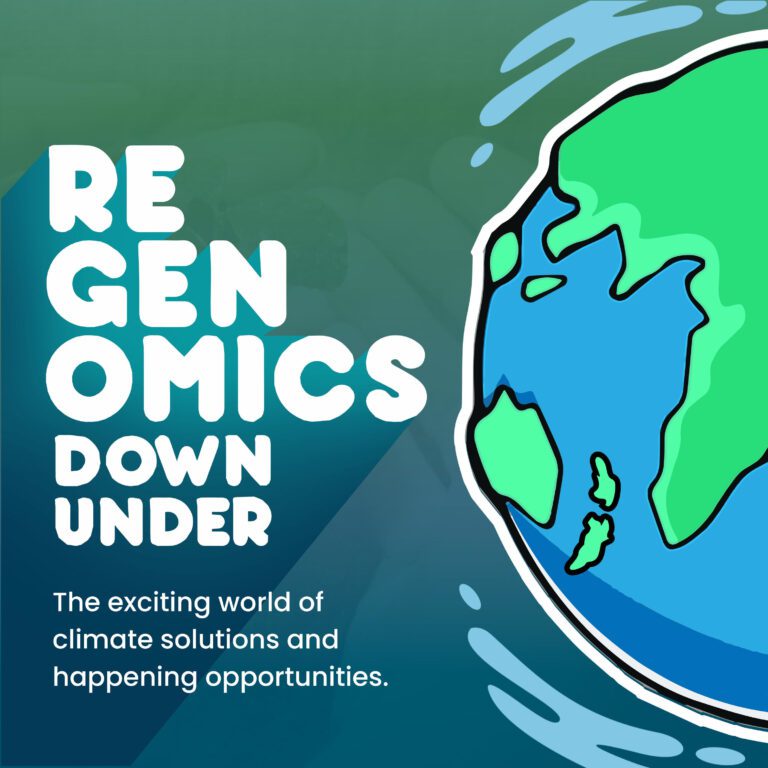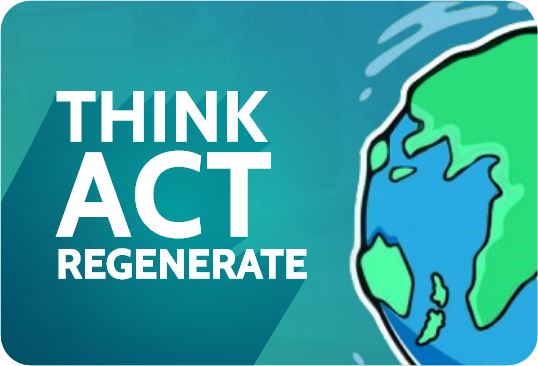
THINK ACT REGENERATE is a podcast by Leigh Baker of ThinkActRegenerate which explores the wealth of regenerative design solutions happening on the ground in Australia and New Zealand, as well as around the world.
INTRO
This podcast is called Regenomics Down Under – “Regenomics” is short for Regional Regenerative Economies – and in previous episodes we’ve looked at what’s happening – mostly locally in Australia.
Today’s a bit different – we’re looking at “What IS regeneration anyway?” and “How can you learn to enable regeneration?”
I interview Kathleen Davies of Ekkremon – a freelance engineering HAZOPS facilitator – who recently finished a course called The Regenerative Practitioner with the Regenesis Group.
We took a deep dive into the practice of regeneration – from regeneration of self to global regeneration.
=====
LINKS
Ekkremon: http://www.ekkremon.com.au/
The Regenesis Group: https://regenesisgroup.com/
Paul Hawken talking about Regeneration and climate solutions: https://www.youtube.com/watch?v=68fY0rSkhRo
=====
CREDITS
Original music and audio editing support by Ian Hopkinson, Human Hacker https://www.humanhackers.live/blog and serial digital entrepreneur.

(Recorded prior to Think Act Regenerate update in 2023)
Today’s a bit different – we’re looking at “What IS regeneration anyway?” and “How can you learn to enable regeneration?”
I interview Kathleen Davies of Ekkremon – a freelance engineering HAZOPS facilitator – who recently finished a course called The Regenerative Practitioner with the Regenesis Group.
We took a deep dive into the practice of regeneration – from regeneration of self to global regeneration. The full conversation went for just over an hour, so here are my key takeaways.
We kicked off with a very basic question:
What is regeneration anyway?
What does “regeneration” do differently from “sustainability”?
Regeneration is about creating more life
Regeneration is about increasing the vitality, the viability, and the evolutionary capacity of the systems in which we are embedded. At the highest, simplest level it’s simply to give new life or energy to something that’s depleted.
As Paul Hawken, founder of Project Drawdown (2014) and Project Regeneration (2021) says:
Regeneration puts life at the heart of every decision.Paul Hawken in REGENERATION: ENDING THE CLIMATE CRISIS IN ONE GENERATION
Stabilise, operate, maintain, improve, regenerate
The Regenesis Group guys basically say that regeneration is the highest level of work that you need to do in a system.
So if you think about any system – whether it’s a factory or a team – the first thing you’ve got to do is stabilise it. So if something’s a bit out of control, out of whack and going crazy, the first question is “How do we stabilise it, get rid of variation?”
And then we need to operate the system. Kathleen and I are factory people, so this is how our world works – first we stabilise the system, then we operate the system, and then we maintain the system.
So those three things – those three levels – only work on existence. They keep the status quo happening – but that’s all that stabilise, operate and maintain does – work on what exists today,
So then how do you improve it? What are the things that you can do to bring it to a higher level of capability – to improve it and then regenerate it?
To go to the next level – so improve and regenerate – you need to go beyond what the system is today – you need to ask different questions. Regeneration works on potential:
- So what else could this system be or become?
- What’s the unrealised potential of what we have today?
Regeneration is about realising potential
Regeneration is the highest level of work that can be done in a system:
Those top levels work on potential. And I don’t think I’ve ever had so much conversation with people about what the hell does potential mean, until I did this course. Because potential is where regeneration starts. And what does that mean? What the hell does that mean?Kathleen Davies, speaking on Regenomics Down Under
There’s the system as it works today – to whatever level it works and with what ever degenerative side effects it’s happening. Then there’s its potential.
So then how do you improve it? What are the things that you can do to bring it to a higher level of capability, improve it, and then regenerate?
Regeneration and improvement work on potential – they ask “So what else could it be?”
Potential is about much more than problems
Regeneration is the process by which potential gets moved into existence.
There’s the system as it works today – to whatever level it works and with what ever degenerative side effects it’s happening – AND there’s the potential it has to be regenerative.
Potential depends on context. So the regenerative development design process starts working from potential – NOT from problems. It starts from the potential of a place and a system.
Regeneration is the process by which the potential of whatever it is – a building, a community, a river valley – moves into existence.
Potential is the possibility or the prospect or what could it be – it’s the gap between what something is and what it could be.
Regeneration starts with PLACE
For the Regenesis Group, regeneration starts with the place. That concept of place and the potential of a place are both big anchor points for the whole regenerative practitioner.
Anything we do starts with the place that we’re in. And that place is fundamental to the potential that we want to bring into existence.Kathleen Davies, speaking on Regenomics Down Under
The Regenerative Practitioner approach starts with trying to view everything as a living system, starting from its place and understanding what its potential is.
It’s all too easy to get over-focused on objects – the things in our environment. We think about buildings, or drains, or cars, or roads. We thing about our projects in terms of the things they deliver. And we think about our projects in the terms of the problems that they solve.
But the thing is not the point – the building is not the point, the project is not the point. The power of design is not in the thing – it’s not the point of the architecture of a building or the engineering of a bridge.
What’s the potential we can maximise?
The point about a thing is more than what it currently does – its about its regenerative capacity. “What regenerative capability does that thing deliver? How could it be designed to increase the vitality, viability and evolutionary capacity of the systems in which it is embedded?”
There’s a Regenesis Group case study that illustrates this point.
The Group was called in to do an energy efficiency project on the building housing a regional food cooperative. However their approach didn’t start with the building – it started with the region in which it was located and the needs of the region.
Rather than redesign the building, they started a conversation about the needs of the place and the people. It took a lot of time (and they initially got fired from the project) – but they started from the place and explore its potential.
The result was a new vision of a cooperative that actively supported local organic farmers and the local community. That vision didn’t just need food storage and retail facilities – it needed the community spaces and and learning and administration facilities to become a truly collaborative food centre.
Potential and place are the foundations of regeneration
If you’re going to make the world better, you have to start somewhere – and there’s no better place to start than the place that you are.
Humans in groups resist change when they perceive it as a threat and a source of loss and risk – and accept it when it offers new, better ways to meet their needs.
So the more time that we spend thinking about regeneration – exploring for how we can increase the vitality, viability and evolutionary capacity of the place we inhabit – the bigger our own potential to deliver regenerative climate solutions.
LINKS
Ekkremon: http://www.ekkremon.com.au/
The Regenesis Group: https://regenesisgroup.com/
Paul Hawken talking about Regeneration and climate solutions: https://www.youtube.com/watch?v=68fY0rSkhRo
CREDITS
Original music and audio editing support by Ian Hopkinson, Human Hacker and serial digital entrepreneur.












